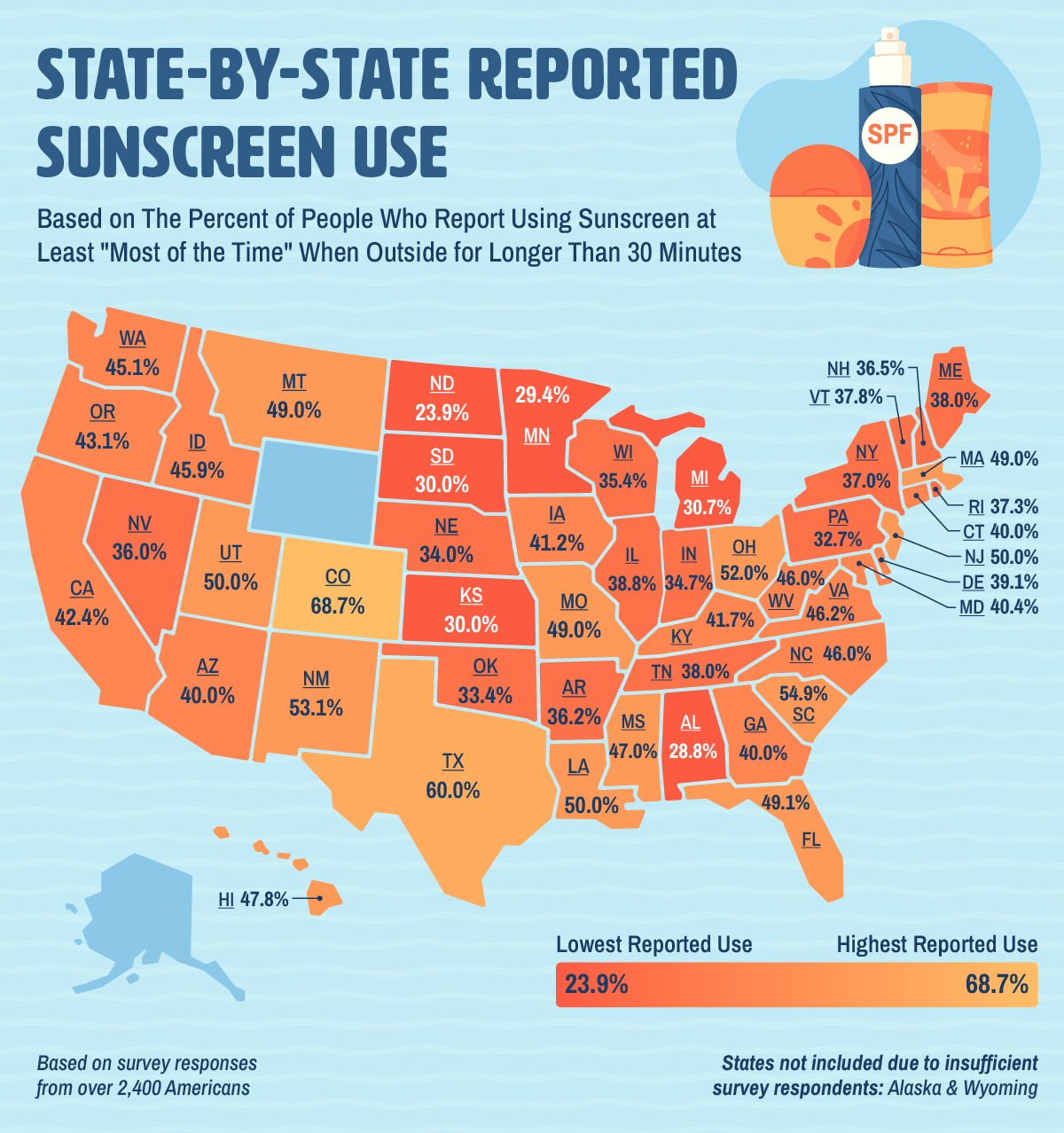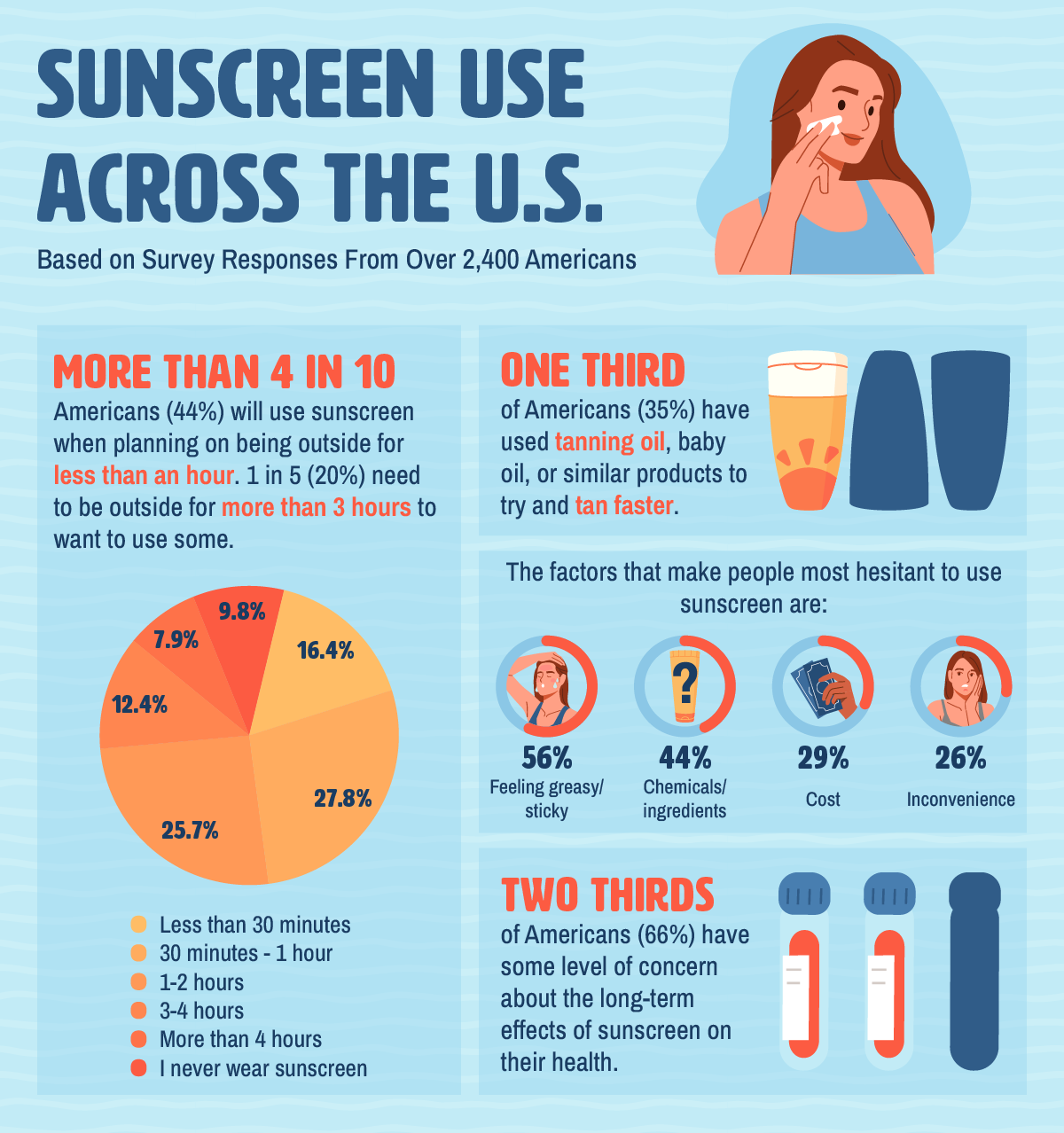Need Help? Call Now
1-800-952-8444Free Consultation
Need Help? Call Now
1-800-952-8444Posted on September 08, 2025

Most people know the sun’s rays can be dangerous, but how seriously they take that risk depends on where they live, and sometimes, on what they believe. To better understand how sunscreen habits stack up across the country and where the risks are highest, we surveyed Americans from every state about their sunscreen use and analyzed CDC data on melanoma rates.
The results reveal striking patterns. Some states lead the way in sun protection, while others lag behind with habits that may contribute to higher rates of skin cancer. This study shines a light on how often Americans reach for sunscreen, what SPF they rely on, and where melanoma poses the biggest threat.

Protecting skin from the sun’s harmful rays is one of the simplest ways to lower the risk of developing skin cancer, yet Americans differ widely in how often they reach for sunscreen. To see where sun safety is most and least common, we surveyed residents and segmented the results by state, asking how often people use sunscreen when outside for more than 30 minutes.
Nationwide, just 41.8% of Americans say they use sunscreen at least “most of the time,” while 10% admit they never do. Those numbers underscore a sizable gap in regular sun protection across the country.
States That Use Sunscreen the Most:
Colorado leads all states in regularly using sunscreen, which isn’t too surprising given its higher elevation and stronger UV exposure. Residents in the Centennial State seem well aware of the risks. States like Texas and South Carolina make sense to be featured high on this list since they have long, sunny seasons that encourage more routine sunscreen use.
New Mexico, like Colorado, sits at a higher altitude and is often associated with intense sun exposure, so residents need to stay on top of protecting themselves when out and about. Ohio is perhaps the most surprising inclusion in the top 5, which suggests that public health messaging plays a large role in sunscreen use beyond climate alone.
States That Use Sunscreen the Least
Northern states like the Dakotas and Minnesota may see sunscreen as less of a daily need than their Southern counterparts due to a less severe summer season, leading to residents underestimating their need for protection.
Kansas’s numbers indicate sun protection may not be top of mind, even with increasingly hot summers, while Alabama is a notable outlier for a Southern state, reflecting more underestimation of UV risks.
When Americans do apply sunscreen, the SPF level they choose also varies widely. On average, people across the country reported using an SPF of 37.9. But regional preferences show clear differences.
States That Use the Highest SPFs:
In Oregon and Maine, coastal living and outdoor activities may encourage residents to pick higher SPF options despite their cooler climates. The beaches in Virginia and the outdoor recreation options like hiking and biking in Idaho and Utah likely drive their residents’ habits of higher-protection sunscreens. The mixed group of states here highlights the awareness that sun safety matters beyond just hot temperatures.
States That Use the Lowest SPFs:
Experts recommend using sunscreen with an SPF of at least 30. When applied properly and reapplied as directed, that level of protection is generally enough for most people. Only one state, Arkansas, reported an average SPF below that threshold. Every other state opts for at least the minimum suggested protection, which is encouraging to see.
Sunscreen use varies pretty dramatically by state. Some residents consistently take sun safety more seriously than others, and it seems the risks tied to the negative effects of the sun aren’t evenly distributed. Next, we’ll dig further into our survey results and find out how Americans use sunscreen and what drives their usage habits.

Sunscreen habits depend on how long individuals plan to be outside, attempts to tan, and even concerns about what’s inside the bottle. Our survey dug deeper into these patterns to see what truly shapes sunscreen use across the country.
Time in the sun matters.
More than 4 in 10 Americans (44%) will put on sunscreen even if they’re planning to be outside for less than an hour. However, 1 in 5 (20%) need to be outdoors for more than three hours before they’ll reach for it, demonstrating just how differently people judge their personal sun risk.
Tanning shortcuts are still common.
About 35% of Americans have used tanning oil, baby oil, or similar products to try to tan faster. Women report this at even higher rates (45%), and baby boomers are the most likely to have tried it (48%) out of any generation. For comparison, only 31% of millennials have, reinforcing the idea that over time we’ve gotten a lot more information about the importance of sun safety.
The feel, the ingredients, and the hassle all weigh heavily.
The most common reasons people hesitate to use sunscreen are the greasy feeling it can leave (56%), worries about the ingredients (44%), the cost (29%), and general inconvenience (26%). These concerns remain hurdles, even with widespread messaging about the importance of sun protection.
Many worry about sunscreen itself.
About 66% of Americans have at least some concern over the long-term health effects of sunscreen. That hesitation could hold some back from applying it as often as they should, despite the clear links between sun exposure and skin cancer.
Sunscreen habits hinge on more than just sunny forecasts. Factors like time outdoors, tanning efforts, product feel, and long-term health concerns all shape how Americans choose to protect their skin—or not.
Now that we’ve got a baseline look at how Americans feel about sun protection, we’ll turn to how these choices play out in real consequences by looking at melanoma rates in every state and major U.S. cities.
While sunscreen habits tell part of the story, actual melanoma rates offer a clearer picture of the stakes. We analyzed the most recent CDC data on melanoma of the skin to see how incidence rates compare across the country. Nationally, in 2021, there were 2.72 cases of melanoma per 10,000 residents, but that risk isn’t spread evenly.
Some states stand out for having melanoma rates well above or below the national average. Let’s find out which states’ residents face the highest and lowest risks.
States With the Highest Rates:
It’s not too surprising to see Minnesota so high on this list, given its relatively low sunscreen use from our survey. Utah also emerges again. Residents there used some of the highest SPF products in the country, yet melanoma rates remain elevated, likely tied to outdoor lifestyles and higher elevation, which intensifies UV exposure. Arizona’s place here isn’t surprising considering intense year-round sun exposure.
States With the Lowest Rates:
Texas stands out here for more than one reason. The Lone Star State had high sunscreen use reported in our survey and sees some of the lowest melanoma rates in the country. That combination points to the protective power of regular sun safety habits, even under an intense Southern sun.
Zooming in on major metro areas shows even sharper contrasts. These cities report the highest and lowest melanoma incidence rates in the country:
Cities With the Highest Rates:
Florida dominates this list, which isn’t surprising given its sunny climate and culture centered around beach outings and outdoor living.
Cities With the Lowest Rates:
Texas appears again, but on the city level, with places like El Paso and McAllen seeing notably low rates. These patterns might tie back to a mix of demographic differences, regional skin cancer awareness, and lifestyle factors that influence sun exposure.
Sun safety looks different across the country. From how often people use sunscreen to the average SPF they choose, habits vary widely. And so do melanoma rates. While some states take sun protection seriously, others lag behind, sometimes with higher risks to match.
These findings highlight the importance of vigilance, not just in daily sun habits but also in recognizing the signs of skin cancer early. When a melanoma is missed or misdiagnosed, the consequences can be life-changing. That’s why Weiss & Paarz is committed to standing by patients who’ve suffered due to delayed or incorrect cancer diagnoses.
To examine skin cancer rates and sunscreen use around the U.S., we analyzed Centers for Disease Control and Prevention data by state and metro area to find the places with the highest rates of melanoma of the skin in 2021, the latest year available. All melanoma data is normalized per 10K residents.
We also surveyed more than 2,400 people from every state over two weeks in June 2025 to see how sunscreen use differs regionally. Respondents shared how often they apply sunscreen, the SPF levels they choose, and other sun protection habits, offering a snapshot of how Americans safeguard their skin today.
Disclaimer: The historical information and specific statistics displayed above are solely designed to provide general knowledge to the public and are being used as a part of attorney marketing. Cited statistics and statements were taken from the research of various independent websites (referenced above). Weiss & Paarz did not take any steps to replicate the findings of any sources used in this infographic, nor were the numbers or results displayed above independently verified by Weiss & Paarz.
Call 1-800-952-8444